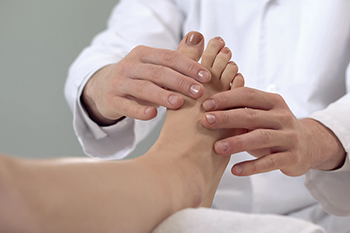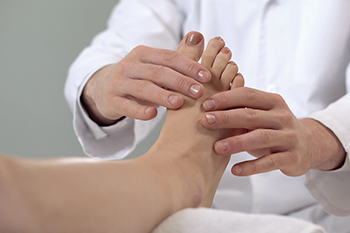

A bunion is a bony bump that can develop on the side of the big toe. If a patient does not respond to more conservative treatments to correct this deformity, then a surgical procedure might be recommended in some cases. Following the surgical procedure, your podiatrist may advise that some kind of physical therapy is performed. Cryotherapy, or cold therapy, might be recommended where the intention is to decrease swelling in the affected area. Potential physical therapy options might also include some kind of gait training, where a physical therapist helps you walk normally or correct any limping tendencies. Lastly, proprioceptive balance training might be another form of physical therapy that is meant to improve and increase stability. If you have bunions and want to learn more about physical therapy following a surgical procedure, contact a podiatrist today.
Foot surgery is sometimes necessary to treat a foot ailment. To learn more, contact Dr. Alan J. Spector of Shore Podiatry. Our doctor will assist you with all of your foot and ankle needs.
When Is Surgery Necessary?
Foot and ankle surgery is generally reserved for cases in which less invasive, conservative procedures have failed to alleviate the problem. Some of the cases in which surgery may be necessary include:
What Types of Surgery Are There?
The type of surgery you receive will depend on the nature of the problem you have. Some of the possible surgeries include:
Benefits of Surgery
Although surgery is usually a last resort, it can provide more complete pain relief compared to non-surgical methods and may allow you to finally resume full activity.
Surgical techniques have also become increasingly sophisticated. Techniques like endoscopic surgery allow for smaller incisions and faster recovery times.
If you have any questions please feel free to contact our office located in Point Pleasant, NJ . We offer the newest diagnostic and treatment technologies for all your foot and ankle needs.

There are various types of running shoes that are tailored to specific running needs. One of the most important things to look for in a running shoe is a perfect fit. This can be easier to do when the shoes are tried on at the end of the day, when the feet are at their largest. It is necessary to make sure there is adequate room between the toes and the top of the shoe, in addition to choosing the right width. There are three categories of running shoes, and it is beneficial to know what kind of running is most likely to be pursued. An everyday running shoe can handle the type of general running that many people do, and is considered to be the most durable. If faster workouts or running races are preferred, a lightweight shoe may be purchased, and it is made with less cushioning. People who like running on rocky trails or dirt may buy a trail running shoe, which has lugs on the sole that may provide better support than other running shoes. If you have questions about what type of running shoe is best for you, please confer with a podiatrist who can direct you toward choosing the best shoe for you.
If you are a runner, wearing the right running shoe is essential. For more information, contact Dr. Alan J. Spector from Shore Podiatry. Our doctor can provide the care you need to keep you pain-free and on your feet.
Choosing the Right Running Shoe for Your Foot Type
To increase performance and avoid the risk of injury, it is important to choose the right running shoe based on your foot type. The general design of running shoes revolves around pronation, which is how the ankle rolls from outside to inside when the foot strikes the ground.
If you have any questions please feel free to contact our office located in Point Pleasant, NJ . We offer the newest diagnostic and treatment technologies for all your foot and ankle needs.

The cuboid bone is located on the outside of the foot and plays an important role in foot movement. Namely, the cuboid bone can act like a pulley during downward foot movement. However, this area of the foot is susceptible to cuboid syndrome, where the ligaments surrounding the cuboid bone become injured. Individuals that have cuboid syndrome can experience a variety of different symptoms, including limping and feelings of pain. To treat cuboid syndrome a medical professional may engage in manipulation treatment. For example, a professional may choose to perform a procedure known as the cuboid squeeze. Through this technique, an individual will have their toes pressed downward while pressure is applied to the area around the cuboid bone. This may be repeated until regular movement is regained. If you have cuboid syndrome, contact a podiatrist today. This foot specialist will be able to treat your condition and answer any questions you may have about techniques like the cuboid squeeze.
Cuboid syndrome, also known as cuboid subluxation, occurs when the joints and ligaments near the cuboid bone in the foot become torn. If you have cuboid syndrome, consult with Dr. Alan J. Spector from Shore Podiatry. Our doctor will assess your condition and provide you with quality foot and ankle treatment.
Cuboid syndrome is a common cause of lateral foot pain, which is pain on the outside of the foot. The condition may happen suddenly due to an ankle sprain, or it may develop slowly overtime from repetitive tension through the bone and surrounding structures.
Causes
The most common causes of cuboid syndrome include:
Symptoms
A common symptom of cuboid syndrome is pain along the outside of the foot which can be felt in the ankle and toes. This pain may create walking difficulties and may cause those with the condition to walk with a limp.
Diagnosis
Diagnosis of cuboid syndrome is often difficult, and it is often misdiagnosed. X-rays, MRIs and CT scans often fail to properly show the cuboid subluxation. Although there isn’t a specific test used to diagnose cuboid syndrome, your podiatrist will usually check if pain is felt while pressing firmly on the cuboid bone of your foot.
Treatment
Just as the range of causes varies widely, so do treatments. Some more common treatments are ice therapy, rest, exercise, taping, and orthotics.
If you have any questions, please feel free to contact our office located in Point Pleasant, NJ . We offer the newest diagnostic and treatment technologies for all your foot care needs.

There are several types of ankle disorders that people can experience. These include sprains, fractures, arthritis, and tendonitis. The function of the ankle is to stabilize the body by supporting the surrounding muscles, tendons, and ligaments. Research has shown that it is the most injured part of the body, and when hurt can negatively impact completing daily activities. An ankle sprain or fracture can happen from unexpectedly stepping off of a curb, causing the ligaments to twist beyond their normal range of motion. Additionally, ankle pain may happen from a sudden fall, with increased force on the ankle joint, often causing immediate and severe pain. There are several types of arthritis that can affect the ankle and can cause limited mobility. Osteoarthritis gradually develops, and can happen when the cartilage between the bones wears down. Having stiff joints may be the result of this type of arthritis. An autoimmune inflammatory disease can produce rheumatoid arthritis, and can attack the body’s healthy tissues. If an injury to the ankle has occurred, post-traumatic arthritis may develop from the stress, and joint stiffness may continue for years following the injury. If you have any type of ankle pain, it is strongly advised that you are under the care of a podiatrist who can effectively diagnose and treat ankle disorders.
Ankle pain can be caused by a number of problems and may be potentially serious. If you have ankle pain, consult with Dr. Alan J. Spector from Shore Podiatry. Our doctor will assess your condition and provide you with quality foot and ankle treatment.
Ankle pain is any condition that causes pain in the ankle. Due to the fact that the ankle consists of tendons, muscles, bones, and ligaments, ankle pain can come from a number of different conditions.
Causes
The most common causes of ankle pain include:
Symptoms
Symptoms of ankle injury vary based upon the condition. Pain may include general pain and discomfort, swelling, aching, redness, bruising, burning or stabbing sensations, and/or loss of sensation.
Diagnosis
Due to the wide variety of potential causes of ankle pain, podiatrists will utilize a number of different methods to properly diagnose ankle pain. This can include asking for personal and family medical histories and of any recent injuries. Further diagnosis may include sensation tests, a physical examination, and potentially x-rays or other imaging tests.
Treatment
Just as the range of causes varies widely, so do treatments. Some more common treatments are rest, ice packs, keeping pressure off the foot, orthotics and braces, medication for inflammation and pain, and surgery.
If you have any questions, please feel free to contact our office located in Point Pleasant, NJ . We offer the newest diagnostic and treatment technologies for all your foot care needs.